This article is a step-by-step guide to help you learn how to massage reflexology points in order to promote overall health and wellness. Reflexology is an ancient practice that has been used for centuries to help restore balance to the body and encourage healing. This guide will provide tips on how to properly massage reflexology points to maximize the benefits and provide relief from a variety of ailments. We will also discuss the possible side effects, so you can be sure to make an informed decision about your reflexology routine.
Contents
What is Reflexology?
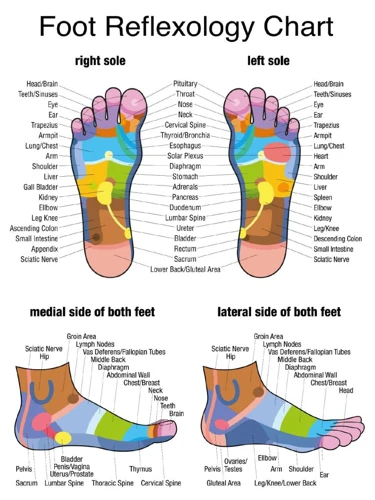
Reflexology is a form of alternative medicine that involves applying pressure to certain points on the feet, hands, and ears. These points are thought to correspond to different organs and systems of the body, and the pressure can help promote relaxation and healing. Reflexology is believed to help stimulate circulation, detoxify the body, boost energy, and reduce stress and anxiety.
How to Give Reflexology Foot Massage
- To begin, find a comfortable spot, either on the floor or on a massage or reflexology table, and have your partner remove their shoes and socks.
- Apply a small amount of massage oil or lotion to your hands and the entire foot.
- Start with gentle strokes to the entire foot, then use your thumb to apply firm pressure along the sole of the foot.
- Pay special attention to the points that correspond to the organs and systems of the body, such as the stomach, heart, and lungs.
- Move your thumb in a circular motion, applying firm pressure for about 10 seconds. You can also use your fingers to massage the entire foot.
- Continue massaging the foot in this manner for about 15 minutes, or until your partner feels relaxed.
- End the massage by gently rubbing the entire foot.
Benefits of Reflexology Massage
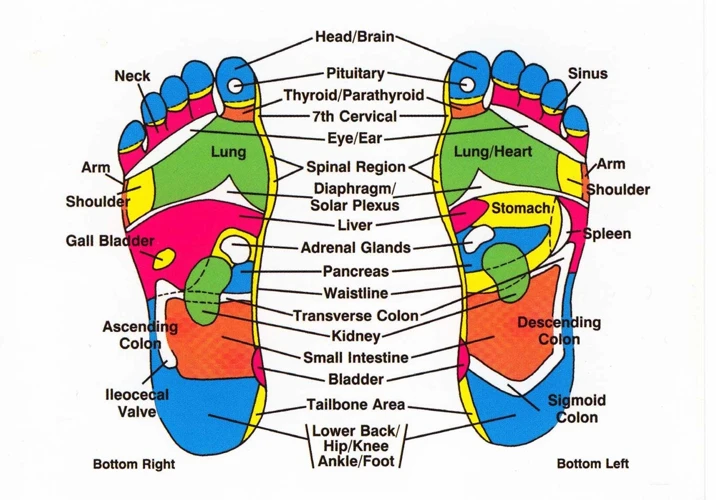
Reflexology massage is a type of massage therapy that focuses on applying pressure to specific points on the feet, hands, and ears to help relieve tension and stress. This type of massage therapy is said to provide numerous benefits, including relief from pain, improved circulation, and a reduction in stress and anxiety. Additionally, reflexology massage can help improve sleep quality, enhance the immune system, and improve overall health. By stimulating certain reflexology points on the feet, hands, and ears, it is believed that the body can be restored to its natural state of balance and equilibrium. This can help reduce pain, improve circulation, and promote overall physical and emotional wellbeing. Furthermore, reflexology massage can help to reduce inflammation, improve digestion, and even help to reduce the symptoms of certain conditions such as headaches and migraines.
Reflexology Points on the Feet
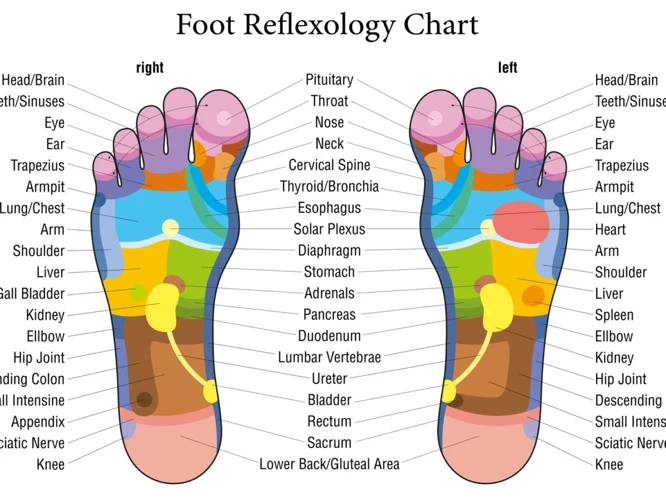
Heel
Starting with the heel, use your thumbs to apply pressure in circular motions. Make sure to apply a consistent amount of pressure to ensure the massage is both effective and comfortable. Remember to focus the massage on the sole of the foot.
Instep
Once you have completed the heel, move to the instep. Use your thumbs to apply pressure in an up and down motion along the arch of the foot. Make sure to be gentle and to focus on your breathing. Use your breathing to guide the massage.
Toes
Finally, move to the toes. Using your fingertips, gently massage each toe in a circular motion. Make sure to be gentle, as the toes are a very sensitive area. Be sure to end the massage with a few gentle strokes.
How to Give a Foot Reflexology Massage
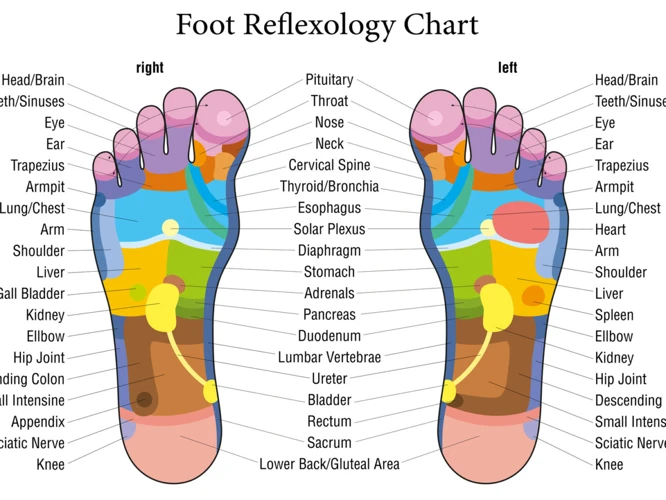
Preparation
Before you begin the massage, it is important to prepare the area by cleansing it with warm water and a mild soap. Make sure to fully dry the area before you start massaging. Additionally, you can use a massage oil to help lubricate the skin.
Massaging the Heel
Start by using your thumb to massage the area around the heel. Move in small circles, applying pressure when needed. Continue for about two minutes, then move to the arch of the foot.
Massaging the Instep
To massage the instep, start by using your thumb to make small circles. Again, apply pressure when needed. Move around the instep, working your way from the heel to the toes.
Massaging the Toes
Lastly, massage the toes. Use your thumbs to make small circles, starting at the base of the toes and working up to the tips. Apply pressure when needed. Continue for around two minutes.
Tips for Massaging Reflexology Points

- Be gentle: Always use light pressure when massaging reflexology points. Aggressive pressure can cause damage to the nerves and the surrounding tissue.
- Apply slow, circular movements: Use slow, circular movements when applying pressure to the reflexology points. This helps to stimulate the reflex points, promote relaxation, and increase circulation.
- Use proper technique: Make sure you are using the proper technique when massaging the reflexology points. Incorrect technique can cause discomfort and can even lead to injury.
- Use essential oils: Essential oils can be used when massaging reflexology points. This helps to moisturize the skin, reduce inflammation, and increase relaxation.
- Warm the reflex area: Before massaging the reflexology points, it is important to warm up the area. This can be done using a warm cloth or a heating pad.
- Drink plenty of water: It is important to drink plenty of water after a reflexology massage. This helps to flush out toxins and promote overall health.
- Take breaks: Take breaks during the massage session to avoid fatigue. This helps to ensure that the massage is effective and comfortable.
Potential Side Effects of Reflexology Massage
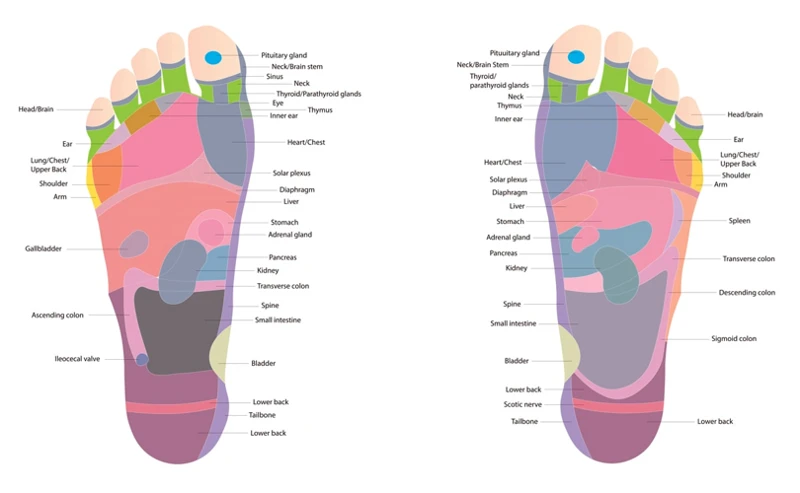
Reflexology massage can be beneficial for many people, but there are some potential side effects to be aware of:
- Soreness or aching in the feet
- Bruising or tenderness in the feet
- Headache, nausea, or dizziness
- Fatigue
- Increased urination
- Increased bowel movements
These side effects are usually mild and temporary, but if they persist or are severe, contact your healthcare provider.
Precautions for Reflexology Massage
- Consult your doctor: Before starting a reflexology massage, it is always better to consult your doctor to make sure it is safe for you.
- Follow hygiene: Make sure you follow all hygiene protocols while performing a reflexology massage, such as washing your hands, keeping your nails short and clean, and wearing gloves.
- Avoid over-massage: Over-massaging can cause pain and discomfort. Therefore, it is important to maintain a gentle touch while applying pressure to the reflex points.
- Be aware of your technique: Each reflex point needs to be massaged in a specific way. Therefore, it is important to be aware of your technique and make sure it is correct.
- Avoid certain areas: Certain areas such as the abdomen, neck, and head should be avoided while performing a reflexology massage.
- Take breaks: It is important to take breaks during a reflexology massage and not to overwork the points.
- Observe reactions: It is important to observe the body’s reaction to the massage. If there is any discomfort, it is best to stop and take a break.
Frequently Asked Questions
What are the Benefits of Reflexology Massage?
- Reduces Stress and Anxiety – Reflexology massage helps to reduce feelings of stress, tension, and anxiety.
- Improves Circulation – Reflexology massage helps to increase circulation throughout the body, which helps to improve oxygen delivery to all organs and tissues.
- Improves Sleep Quality – Reflexology massage helps to improve sleep quality and reduce insomnia.
- Relieves Pain – Reflexology massage helps to reduce pain and discomfort associated with chronic pain conditions, such as arthritis and sciatica.
- Boosts Immunity – Reflexology massage helps to stimulate the lymphatic system, which helps to boost immunity.
- Reduces Toxins – Reflexology massage helps to reduce toxins in the body and improve overall health.
Is Reflexology Massage Effective in Relieving Stress and Tension?
Yes. Reflexology massage is an effective way to reduce stress and tension. This type of massage targets key reflex points throughout the body to promote relaxation, decrease stress and tension, and improve overall wellbeing.
- It can help to relieve stress-related symptoms such as headaches, muscle tension, and insomnia.
- It helps to reduce anxiety, depression, and fatigue.
- It can improve circulation and reduce blood pressure.
- It can help to improve mood and boost energy.
- It can help to relieve pain and promote healing.
Reflexology massage can be used in combination with other relaxation techniques such as deep breathing, visualization, and meditation for maximum benefits. Regular sessions with a trained reflexologist can help to reduce stress and tension and improve overall well-being.
How often should reflexology massage be done?
Reflexology massage should be done on a regular basis, such as once a week or every two weeks, for best results. It is important to understand that reflexology massage is not a one-time solution, but rather a long-term therapy that should be used to maintain optimal physical and mental health.
Are there any potential health risks associated with reflexology massage?
Reflexology massage is generally safe, however there is a risk of developing soreness and bruising in the area where the massage is applied. People with certain medical conditions should consult their doctor before receiving a reflexology massage as it may not be suitable for them. Also, people should be aware of the potential risk of infection and always use clean, disposable materials when performing reflexology massage.
What Tools are Needed for Reflexology Massage?
Reflexology massage requires minimal equipment. You will need a massage oil or lotion, a comfortable space to sit, and a reflexology chart. If you are performing the massage on yourself, a reflexology stick or pen can be used to apply firm pressure to the reflex points. If you are performing the massage on someone else, you may also need soft-tipped massage tools such as a reflexology ball or a wooden dowel.
Conclusion
Reflexology massage is an effective way to relieve tension and promote relaxation. It can be used to target specific areas of tension in the body and can be done in the comfort of your own home. By following a few simple steps and using the right massage techniques, you can reduce your stress and improve your overall wellness.

